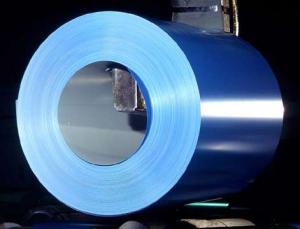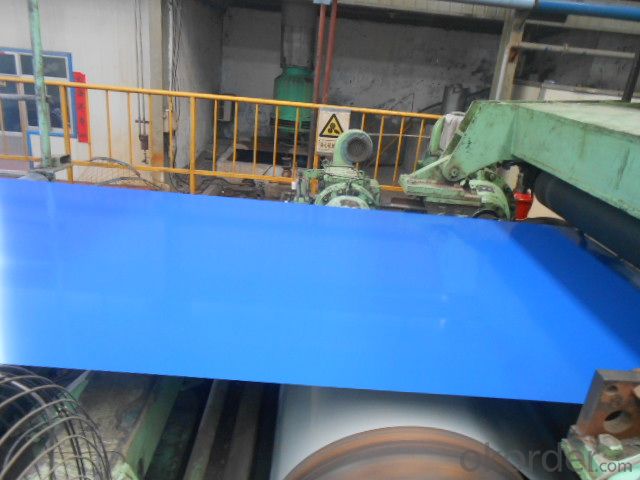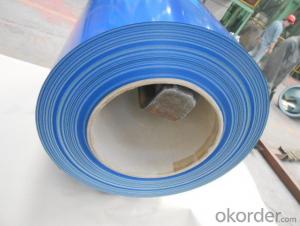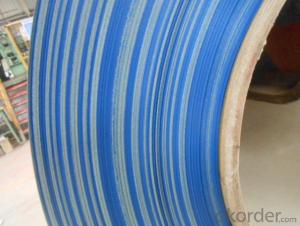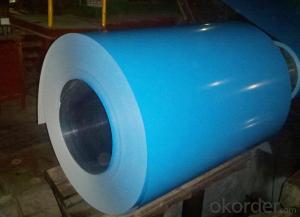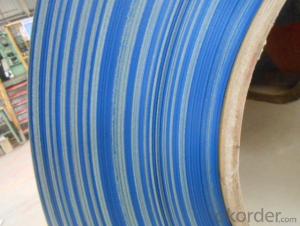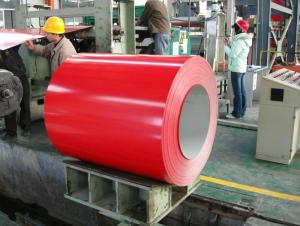Pre-Painted GI Steel Coil in Blue Color
- Loading Port:
- China Main Port
- Payment Terms:
- TT or LC
- Min Order Qty:
- 50 m.t
- Supply Capability:
- 10000 m.t/month
OKorder Service Pledge
OKorder Financial Service
You Might Also Like
1. Pre-Painted GI/GL Steel Coil Description:
With GI as base material, after pretreatment (degrease and chemical treatment ) and liquid dope with several layers of color, then after firing and cooling, finally the plate steel is called pre-painted galvanized (aluzinc) steel. Pre-painted galvanized steel is good capable of decoration, molding, corrosion resistance. It generally displays superior workability, durability and weather resistance.
2.Main Features of the Pre-Painted GI/GL Steel Coil:
• Excellent process capability
• Smooth and flat surface
• Workability, durability
• Excellent heat resistance performance
• High strength
• Good formability
• Good visual effect
3.Pre-Painted GI/GL Steel Coil Images
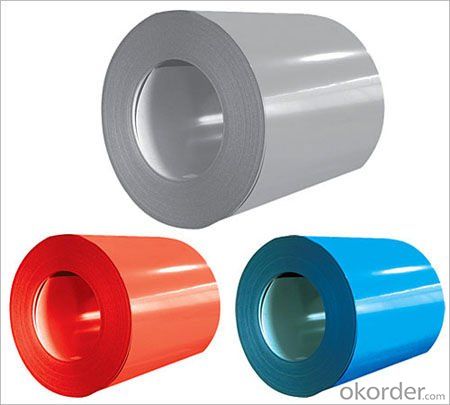
4.Pre-Painted GI/GL Steel Coil Specification
Standard: AISI, ASTM, BS, DIN, GB, JIS
Grade: DX51D, DX52D
Thickness: 0.17-2.0mm
Brand Name: KMRLON
Model Number: coil
Type: Steel Coil
Technique: Cold Rolled
Surface Treatment: Coated
Application: Boiler Plate
Special Use: High-strength Steel Plate
Width: 20-1250mm
Length: customized
commoidty: pre-painted galvanized steel coil
Thickness: 0.13-4.0mm
width: 20-1250mm
zinc coating: 40-180g/m2
printing thickness: top side: 20+/-5 microns, back side: 5-7 microns
color: all RAL color
surface treatment: color coated
coil weight: 4-7 tons
coil ID: 508/610mm
packaging: standard seaworthy packing
5.FAQ of Pre-Painted GI/GL Steel Coil
1. What’s the application of this product?
Roof, roof structure, surface sheet of balcony, frame of window, etc.
2. What’s the brand of the paint?
We use the best brand of all of the word—AKZO.
3. How to guarantee the quality of the products?
We have established the international advanced quality management system,every link from raw material to final product we have strict quality test;We resolutely put an end to unqualified products flowing into the market. At the same time, we will provide necessary follow-up service assurance.
4. How long can we receive the product after purchase?
Usually within thirty working days after receiving buyer’s advance payment or LC. We will arrange the factory manufacturing as soon as possible. The cargo readiness usually takes 15-25 days, but the shipment will depend on the vessel situation.
- Q: I'm talking about the sort of carbon fiber that's used in the auto industry (mostly in supercars).If an object made of steel were to be copied by an exact same object, but made of carbon fiber - how lighter would the carbon fiber object be?For example, if a table is made of steel and it weighs X, how much will it weigh if it were made of carbon fiber?Thanks.
- Carbon fiber doesn't really refer to a single material (steel doesn't either, but most steels have similar densities). Pure carbon fiber is just that, fibers made of 90+% carbon. Carbon fiber in the context of cars usually refers to carbon fiber-reinforced polymers rather than plain woven fibers. The polymer adds rigidity to what would otherwise just be like a sheet of fabric. The density depends on the polymer used and the ratio of polymer:fiber. For 50% fiber by volume in epoxy, it has a density of 1.6 g/cm^3. Steel has a density of ~7.8 g/cm^3. So, by volume, steel is almost 5 times heavier.
- Q: Can steel coils be used in the production of agricultural equipment?
- Yes, steel coils can be used in the production of agricultural equipment. Steel is a commonly used material in the manufacturing of agricultural machinery such as tractors, plows, harvesters, and irrigation systems. Steel coils can be formed, cut, and shaped to create various components and structures required for these equipment. The strength, durability, and corrosion resistance of steel make it suitable for withstanding the harsh conditions and heavy workloads involved in agricultural operations.
- Q: Can steel coils be coated with QR codes?
- Yes, steel coils can be coated with QR codes. QR codes can be printed or engraved onto the surface of the steel coils, allowing for easy scanning and identification of the coils.
- Q: basically all the info you can find about s1 tool steel i found a bunch about annealing, and hardening, tinsel strength and stuff like that but i need MORE!!!!!
- s1 tool steels (also calles high-speed steels) are used in the manufacture of cutting tools such as drills, reamers, taps, milling cutters, and lathe cutting tools. They are made from different types of steels. They are generally used in machine shops for making holes. .
- Q: I'm not really sure if carbon steel is considered a metallic material.
- yes its iron with carbon in it
- Q: What are the common packaging defects in steel coils?
- Steel coils can have various packaging defects. These include edge damage, rust or corrosion, coil slippage, coil damage during handling, inadequate protection against impacts, improper coil strapping or banding, and insufficient labeling or identification. When the edges of the steel coil are not properly protected or wrapped, it can lead to dents, scratches, or deformities. This compromises the coil's integrity and can result in reduced performance or structural issues. If steel coils are not adequately protected during packaging, they can be prone to rust or corrosion. Moisture or harsh environmental conditions can cause oxidation, resulting in rust spots or widespread corrosion. This weakens the steel and makes it less suitable for its intended use. Improper packaging can cause the coils to shift or slip within the packaging material during handling or transportation. This can lead to misalignment, deformation, or interlocking, making it difficult to separate or use the coils effectively. Rough handling, improper lifting techniques, or inadequate support can cause mechanical damage to the steel coils. This can result in dents, scratches, or more severe structural damage, impacting their functionality or performance. Steel coils need sufficient protection against impacts during transportation or storage. Insufficient padding or cushioning can lead to deformities, dents, or fractures in the coil due to impacts or collisions. If the strapping or banding used to secure the steel coils is not properly applied or tightened, it can cause coil slippage or even complete unraveling of the packaging. This creates a tangled mess of steel coils, making them difficult to handle, transport, or use. Proper labeling and identification are crucial for efficient handling, storage, and tracking of steel coils. Inadequate or incorrect labeling can cause confusion, delays, or even loss of the coils during transportation or storage. To prevent these packaging defects, it is important to follow proper guidelines, use appropriate materials, provide adequate protection, and ensure proper labeling and identification of steel coils. Regular inspections and quality checks throughout the packaging process can help identify and rectify any defects before shipping or use.
- Q: During fatigue testing of any material (especially for steels), why is strain-control mode preferred over stress control mode?
- because metals, like steel, are ductile and will stretch before breaking. Straining the metal is stretching it, stressing the metal is applying a shearing force or bending until there is an actual metal failure. A sheet metal strap 1inch across and 24 gauge metal is commonly used to support metal ducting systems in construction. These have an average strain to failure weight load as high as 16,200 lbs. As reported by the smacna index, they will safely hold 6800 pounds. Of more interest is the screws used to hold the strap to the duct. While they are grade 3, fairly strong, they strain to 1400 pounds when properly installed, and are safely able to support 650 pounds, unless they are overtorqued (stripped) and this quickly drops to 400 pounds and 125 pounds...big difference.
- Q: Are steel coils susceptible to damage during storage or transportation?
- Yes, steel coils are susceptible to damage during storage or transportation. Factors such as mishandling, improper stacking, exposure to moisture or extreme temperatures, and inadequate packaging can lead to dents, scratches, corrosion, and even deformation of the coils. Adequate precautions and secure packaging are necessary to minimize the risk of damage during storage or transportation.
- Q: What are the different methods of blanking steel coils?
- There are several methods for blanking steel coils, including shearing, laser cutting, and waterjet cutting. Shearing involves using sharp blades to cut the coil into desired shapes. Laser cutting utilizes a high-powered laser beam to accurately cut through the steel. Waterjet cutting involves the use of a high-pressure stream of water mixed with abrasive materials to cut the coil. These methods offer different levels of precision, speed, and cost-effectiveness depending on the specific requirements of the blanking process.
- Q: What is the use for spring steel that take advantage of its unique properties?
- The primary use is for springs. It can be deflected to a large extent by applying a force it will return to its original shape when the force is removed. The force/displacement relationship tends to be a constant. A lesser use is to use spring steel wire as a vibrating string on a stringed instrument.
Send your message to us
Pre-Painted GI Steel Coil in Blue Color
- Loading Port:
- China Main Port
- Payment Terms:
- TT or LC
- Min Order Qty:
- 50 m.t
- Supply Capability:
- 10000 m.t/month
OKorder Service Pledge
OKorder Financial Service
Similar products
Hot products
Hot Searches
Related keywords
